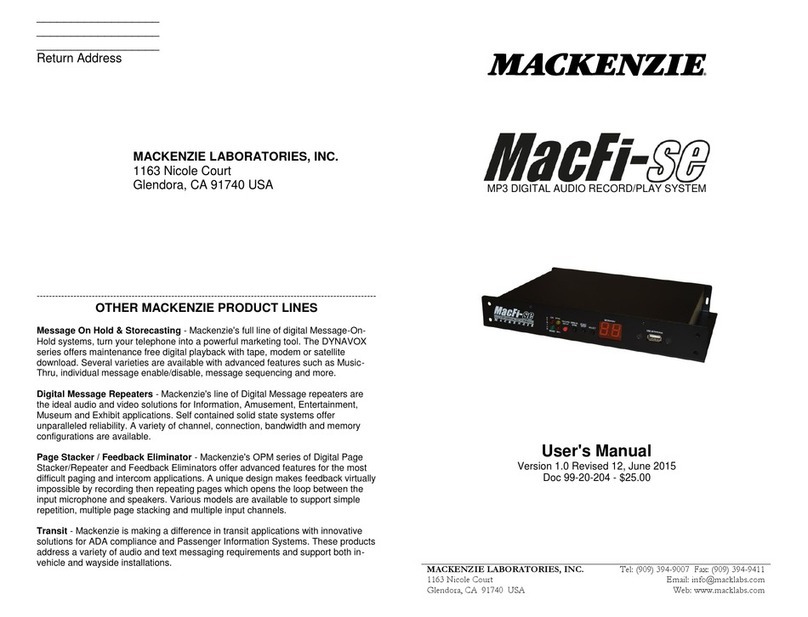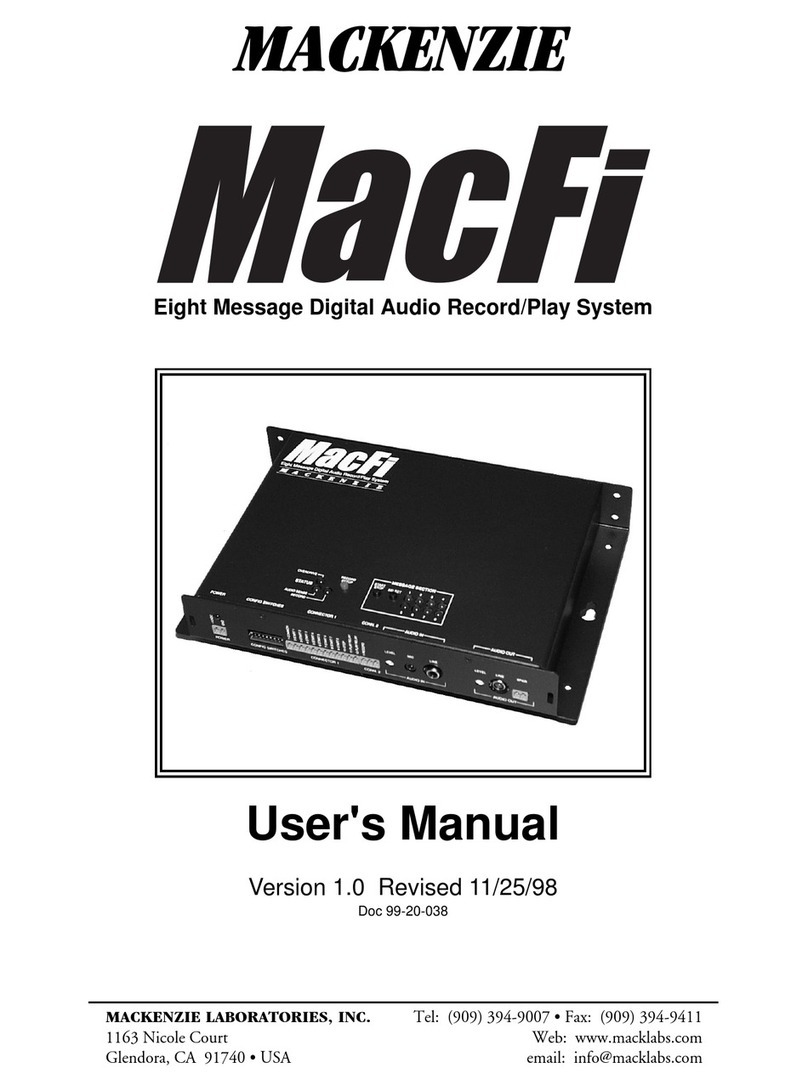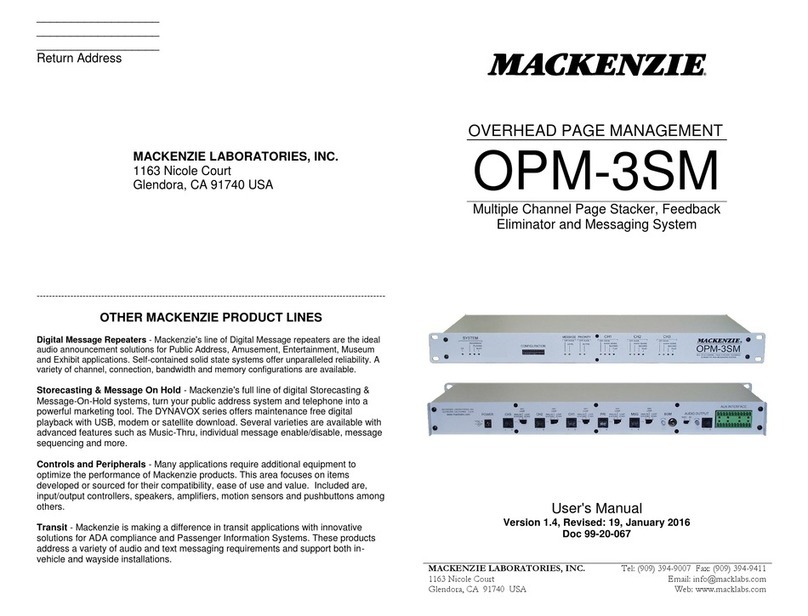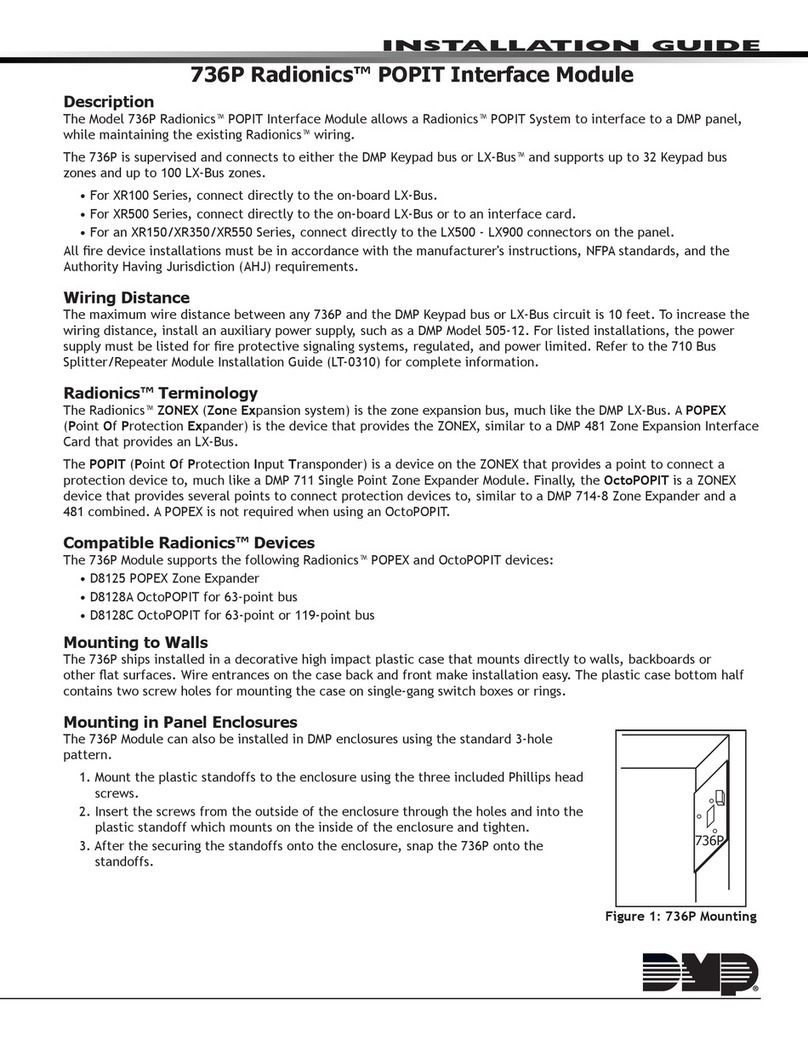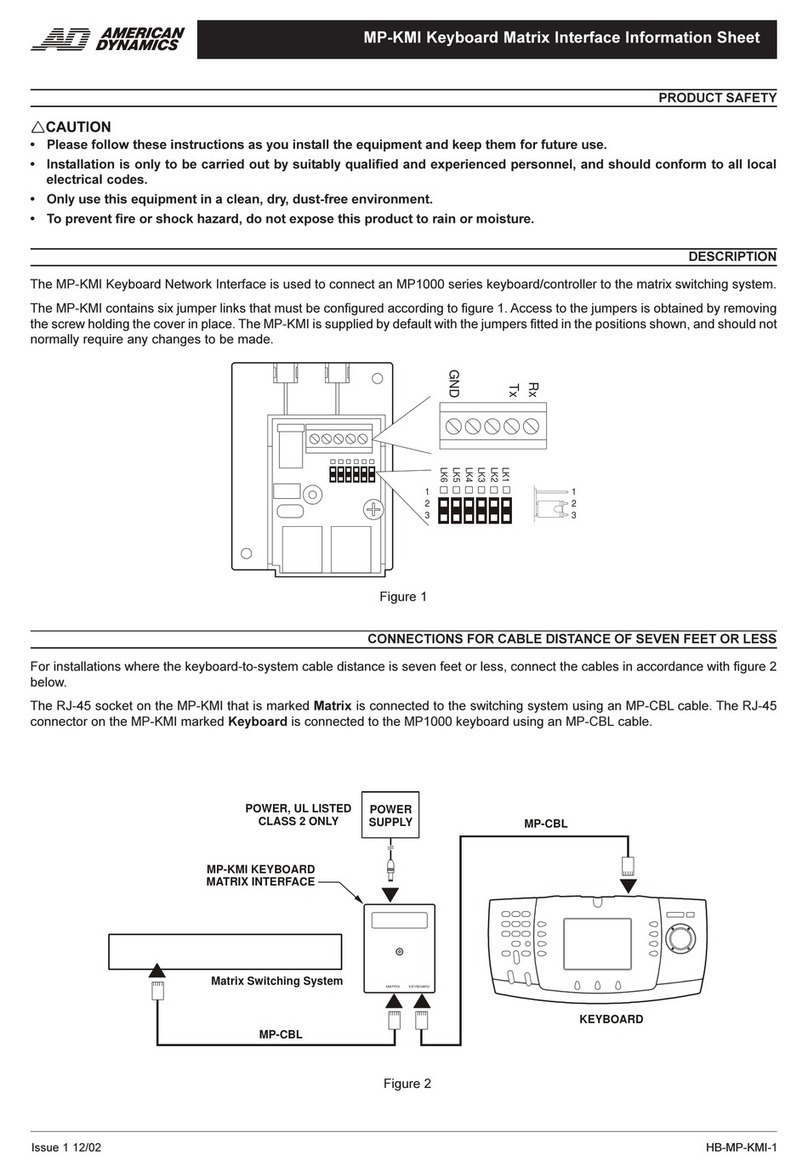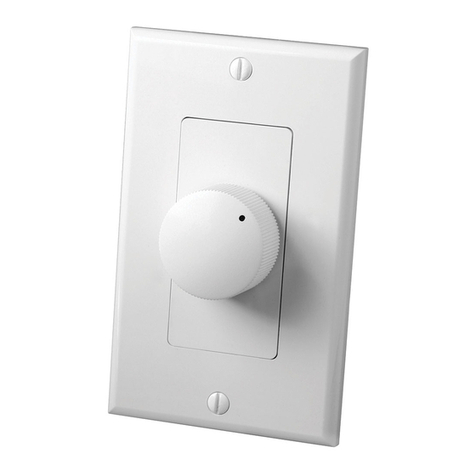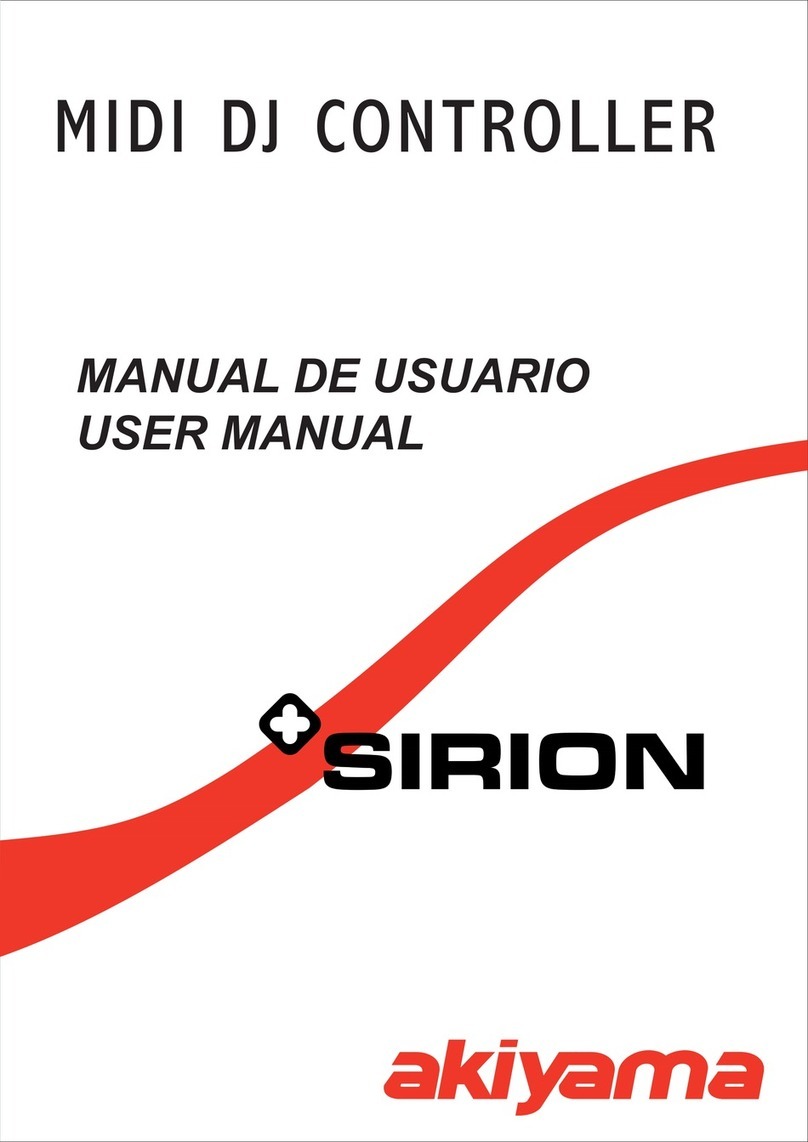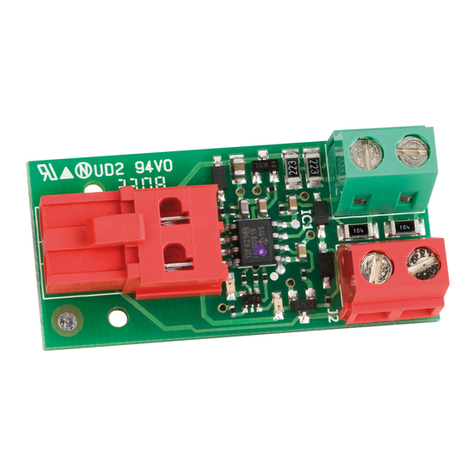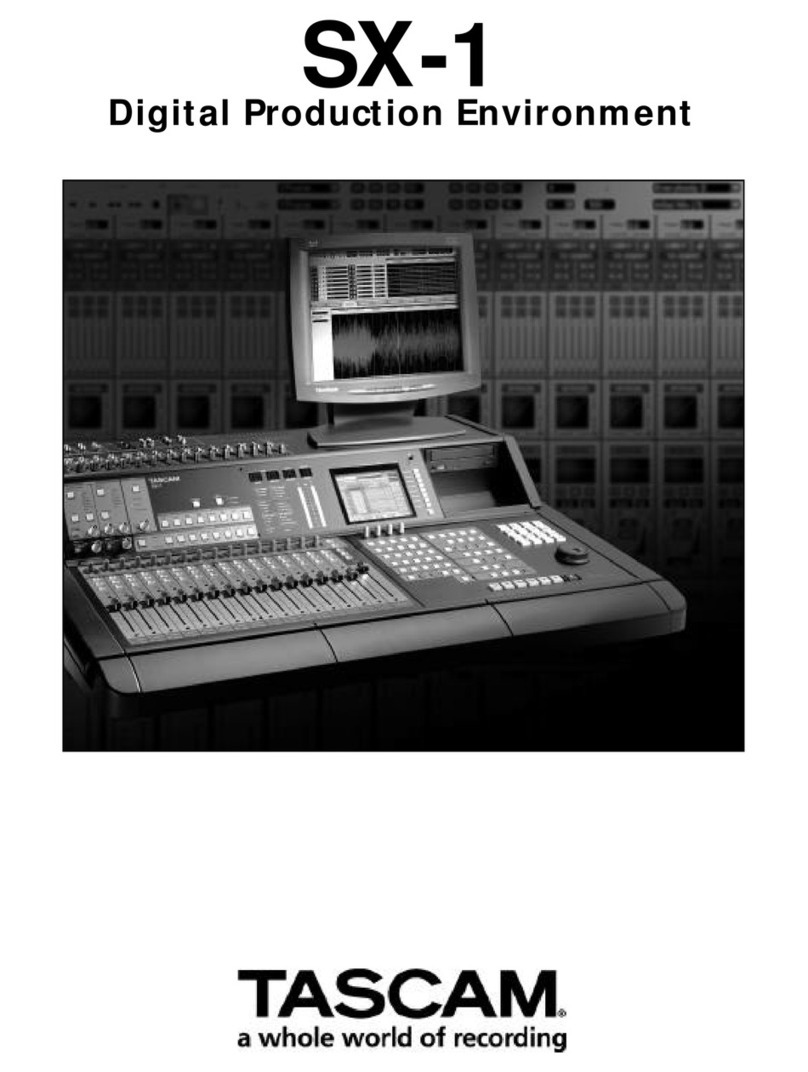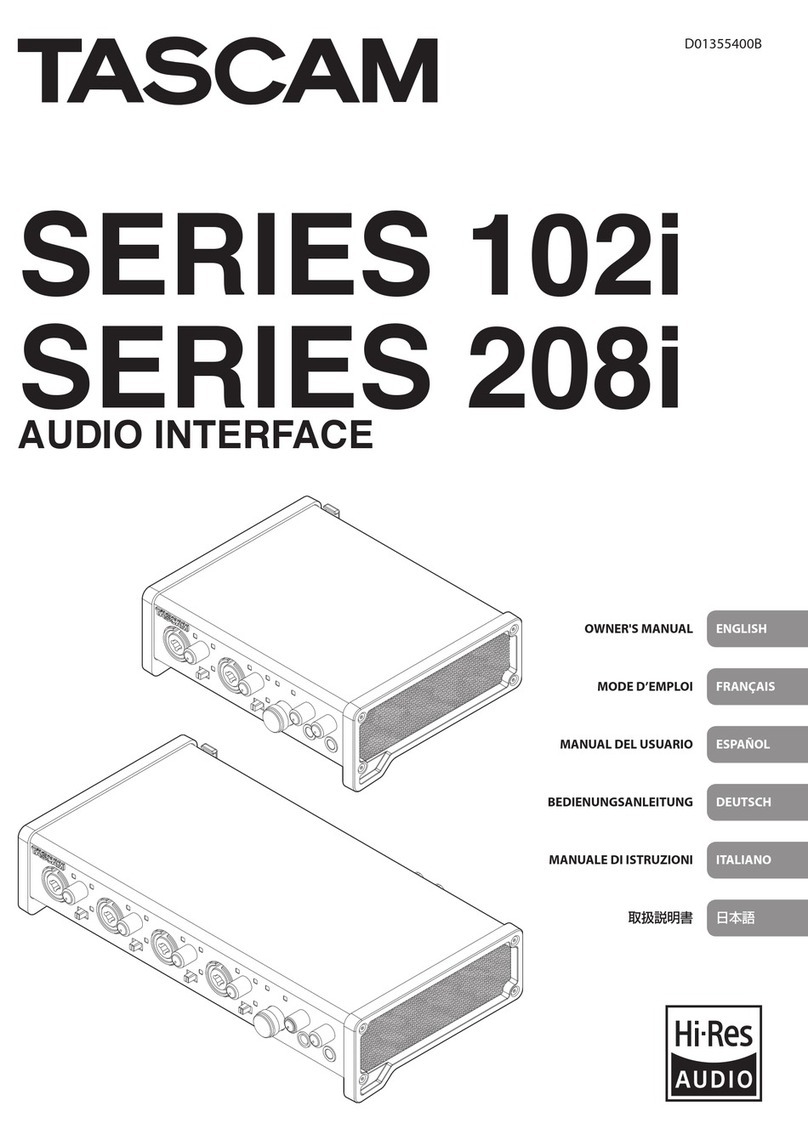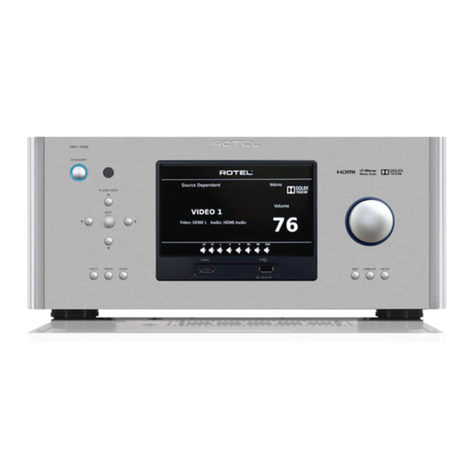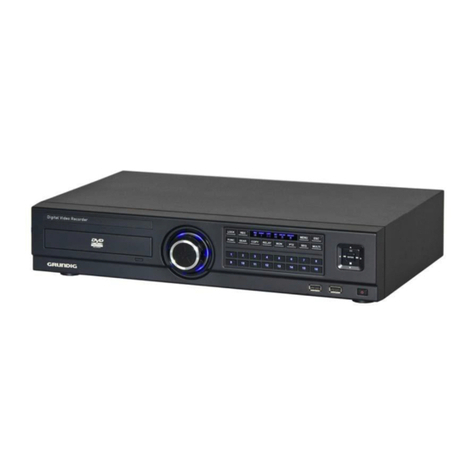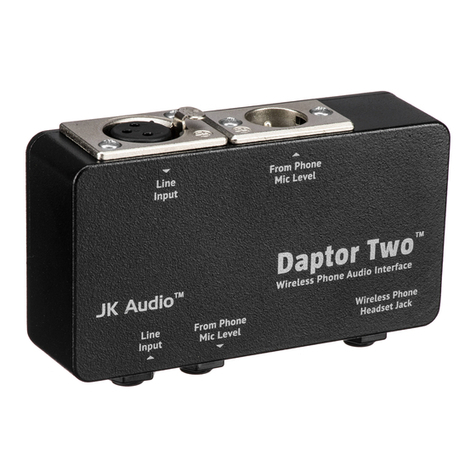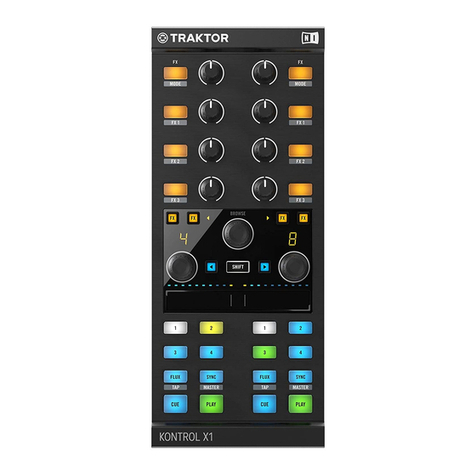Mackenzie MacFi-se Installation and operating instructions

12
3. CREATING AN MP3 FILE WITH SOUND RECORDER
Run the Sound Recorder application (typically in Start> Programs> Accessories>
Entertainment) that is supplied with Windows.
Record a file from the mic or line in of your sound card by pressing the round red
button, or open an existing file by selecting File> Open.
Select File> Save As. Select the Change button by Format. Select MPEG Layer-3 at
the Format dialog. Select the Attributes you desire such as 32kbps, 44,100, Mono.
Press OK. Modify the File Name to have the .MP3 extension then press Save. Now
this file may be transferred to the MacFi-se via the DLD serial command.
NOTE: Sound Recorder only creates voice quality MP3 files. If you
want full fidelity MP3 files, we suggest you obtain one of the many
commercially available ripper or editing software packages.
MACKENZIE LABORATORIES, INC.
1163 Nicole Court
Glendora, CA 91740 USA
Tel: (909) 394-9007
ax: (909) 394-9411
Web: www.macklabs.com
Email: info@macklabs.com
MP3 DIGITAL AUDIO RECORD/PLAY SYSTEM
Enhanced Operation Addendum
Version 1.0, 26 June 2014
Doc 99-20-205 - $25.00

2
Table of Contents
1. MacFi-se ENHANCED FEATURES....................................................................... 3
1.1 Serial Communication(RS-232)......................................................................... 3
1.1.1. Physical Connection and Protocol........................................................ 3
1.1.2. Toggle Baud between 9,600 and 115,200............................................ 3
1.1.3. Command List and Descriptions .......................................................... 3
1.1.4. Bass- BAS ........................................................................................... 4
1.1.5. Memory Bad Blocks Test - BBT........................................................... 4
1.1.6. Restore Default Configuration - CFG ................................................... 5
1.1.7. Message Directory Listing - DIR........................................................... 5
1.1.8. Delete Message - DEL......................................................................... 5
1.1.9. Download an MPEG File - DLD ........................................................... 5
1.1.10. Delay before play - DLY....................................................................... 6
1.1.11. Command listing- LST ......................................................................... 6
1.1.12. Pause between play repeats - PAS...................................................... 6
1.1.13. Number of Plays per trigger - PLS ....................................................... 6
1.1.14. Play Message - PLY ............................................................................ 7
1.1.15. Set Message Enable - PRI................................................................... 7
1.1.16. Record- REC ....................................................................................... 8
1.1.17. Reset- RST.......................................................................................... 8
1.1.18. Initialize Configuration Table - SHP ..................................................... 8
1.1.19. Stop-STP............................................................................................. 9
1.1.20. Display Status - STS............................................................................ 9
1.1.21. System Information- SYS..................................................................... 9
1.1.22. Treble- TRE ......................................................................................... 9
1.1.23. Upload File - ULD .............................................................................. 10
1.2 Synchronization .............................................................................................. 10
1.3 Sync Relay ..................................................................................................... 10
1.3.1. Sync In .............................................................................................. 10
1.3.2. Manual Sync...................................................................................... 10
1.3.3. Sync Indicator.................................................................................... 10
2. USING HYPERTERMINAL FOR RS-232 COMMUNICATION............................. 11
3. CREATING AN MP3 FILE WITH SOUND RECORDER ...................................... 12
11
2. USING HYPERTERMINAL FOR RS-232 COMMUNICATION
Run the Hyperterminal application (typically in Start> Programs> Accessories>
Communications) which is supplied with Windows.
Enter the name of your new connection, such as MacFi-se , and press OK.
At the "Connect to" dialog select the serial port that the MacFi-se is connected to in
the Connect using dialog box (ex. COM 1).
At the Port Settings dialog select 9600 bits per second (or 115200 if you have toggled
the baud rate on power up), 8 data bits, None parity, 1 stop bits and "None" for flow
control.
Press enter to get the MFI> prompt.
Downloading a File - Follow the instructions for the DLD command. After you have
executed the command and the "C" characters begin to be displayed, select Transfer>
Send File from Hyperterminal. Browse to locate the file you wish to send, Select
Ymodem as the protocol and select Send. You should see a dialog noting the
progress and success of your transfer.
Changing The Baud Rate - Disconnect the session by Selecting Call> Disconnect.
Then Select File> Properties. Select Configure and modify Bits per second to be either
9600 or 115200. This setting depends on the power on rate (LO, HI) of the machine as
explained in the Toggle Baud between 9,600 and 115,200 Section. Default baud rate
is 9600.

10
1.1.24.Upload File - ULD
This command configures the MacFi-se to send a file via YMODEM to another
controller or computer.
Syntax;
ULDmsgnumber
Where;
msgnumber = 1 - 99.
Example;
ULD2<CR> initiates upload sequence for message 2. After command is
executed, an YMODEM transfer of the file should also be initiated on the
controller or computer.
1.2 Synchronization
The synchronization capabilities of the MacFi-se allow for 100 Sync Relay outputs
per message location. Sync Relay outputs may be programmed automatically or
manually. Sync pulses must be at least 100mS in duration and spaced at least
100mS apart.
1.3 Sync Relay
Three terminal pluggable connector.
Position 2 Sync Relay Output, Common
Position 3 Sync Relay Output, Form A, connects to position 2 when activated
1.3.1. Sync In
Line level RCA input. This input contains an audio sensor which detects tones for
synchronization. During recording the system stores a 250mS sync pulse each time
a tone is detected. During playback, the Sync Relay output(normally open) will be
activated at the time the tone was detected.
1.3.2. Manual Sync
Push button intended for manual or real time programming of the Sync Relay.
During recording the system stores a 250mS sync pulse each time a button press is
detected. During playback, the Sync Relay output(normally open) will be activated
at the time the button was pressed. When the system is idle, pressing and holding
the Manual Sync button will show the current baud rate on the Status Display.
1.3.3. Sync Indicator
The Sync Indicator is an LED which will activate for each synchronization pulse.
This indicator will function during both automatic and manual modes of sync
programming as well as during playback.
3
1. MacFi-se ENHANCED FEATURES
The purpose of this manual is to document and explain the added features of the
MacFi-se. In brief, these features include RS-232 (Serial) control and Synchronization
Relay. These features also change some physical attributes of the original MacFi unit.
These physical changes include, a 3 position Euro style connector for serial
communications, a RCA type input for automated sync track encoding, a sync
pushbutton for manual sync track encoding. The sync track relay populates positions 2
and 3 of Connector 2, which were previously unused.
1.1 Serial Communication(RS-232)
1.1.1. Physical Connection and Protocol
Three terminal pluggable connector. The Serial Communication port operates at
9600 / 115,200 baud with 8 data bits, 1 stop bit and No parity. This port is
designed for communication with a local user or controller over a short reliable
interface. No error detection scheme is implemented over this interface. All
command characters and returned information are in ASCII format. When
connected properly, the system prompt MFI> will be returned.
Position 1 Receive
Position 2 Transmit
Position 3 Ground
1.1.2. Toggle Baud between 9,600 and 115,200
The MacFi-se supports two RS-232 (Serial) port speeds, 9600 and 115200 to
maintain compatibility with control systems and decrease file download times.
These rates are toggled by holding the Manual Sync button during power up.
1. Remove power from the system
2. Push and hold the Manual Sync button.
3. Reapply power to the system while holding the Manual Sync button. The
Status Display will show Lo or Hi or indicating the port speed of 9600 or
115200 respectively. Repeat the process to change the speed. To check the
current baud rate, press and hold the Manual Sync button and the speed will
show on the Status Display
1.1.3. Command List and Descriptions
At the MFI> prompt various commands may be issued to control record,
playback and other functions of the MacFi-se . Each command and associated
string must be followed by Carriage Return or <CR>.

4
Command List
CMD
Options
Description
BAS [<+9 to -6] Set Message Bass Level.
BBT *Memory Bad Blocks Test.
CFG *Restore Default Configs.
DIR Directory of Message Priority.
DEL [<1-99>] *Delete Message.
DLD [<1-99>] Download MPG Message.
DLY [<0,+/-99>] (+=sec, -=min) Delay Before 1st Play Start.
LST This Commands Listing.
PAS [<0,+/-99>] (+=sec, -=min) Pause Between Play Repeats.
PLS [<1-99>] Number of Plays per Trigger.
PLY [<1-99>,<1-99>,<0,+/-99>] Play Message,Repeat,Delay.
PRI [<1-99>,<E>nable/<D>isable] Set Priority Message,Enable.
REC [<1-99>,<1-99>,<0,+/-99>] Record Message,Delay,Time.
RST Warm Reset System
SHP *Init Configs & Erase Messages.
STP Stop Message Playback.
STS [<0>Off/<1>On] Display Play Status Messages.
SYS Display System Information.
TRE [<+9 to -6] Set Message Treble Level.
ULD [<1-99>] Upload MPG Message.
* = Confirmation Required
1.1.4. Bass- BAS
This command is to set the bass level of the MacFi-se .
Syntax;
BASvalue
Where;
value = 0 or -6 to +9, (default = 0)
Example;
BAS+9<CR> sets bass level to +9dB
1.1.5. Memory Bad Blocks Test - BBT
Allows the user to format the internal SD Card. The process is completed when
the MFI> prompt is given to the user. All audio memory will be erased by
performing this function.
Syntax;
BBT
Example;
BBT<CR> will trigger Y/N confirmation in order to proceed with the format
9
1.1.19. Initialize Configuration Table - SHP
This command allows the user to format the memory card and reset system
settings to factory default. This command will erase the entire memory and reset
all of the configurable settings to those specified in the Product Specification.
Example;
SHP<CR>
The system may take up to 10 sec before it’s ready to receive new commands.
1.1.20.Stop-STP
This command stops the playback or recording of messages and clears the
message queue.
Example;
STP<CR>
Will stop any currently playing message, or recording message on the MacFi
system. If nothing is currently playing or recording, this command will have no
effect.
1.1.21.Display Status - STS
This command toggles the display of RS-232 feedback from the MacFi-se ON or
OFF. With Status ON, the system will send a message to the RS-232 port
indicating that the particular message has started/stopped. This status may be
used to control other systems based on the mode of the MacFi-se.
Syntax;
STSvalue
Where;
value is 0 for off and 1 for on
Example;
STS1<CR> will turn display status on
1.1.22.System Information- SYS
This is a diagnostics feature for testing purposes only. Certain status information
from the MacFi unit will be output to the user when this command is entered.
Example;
SYS<CR>
1.1.23.Treble- TRE
This command is to set the treble level of the MacFi-se .
Syntax;
TREvalue
Where;
value = value = 0 or -6 to +9, (default = 0)
Example;
TRE+9<CR> sets treble level to +9dB

8
1.1.16.Record- REC
This command is to used to record new messages or replace existing messages
in the MacFi-se . The Record command can be open ended, meaning that the
recording is started with this command but must be stopped using the Stop
command or the time constraint.
Syntax;
RECmsgnumber,delay,time
Where;
msgnumber = the message location to be played<1-99>
delay = the number of seconds to delay before starting the record process<1-
99>
time is the duration of recording time (+) 1 thru 99 for seconds or (-) 1 thru 99 for
minutes.
Example;
REC8,10,-4<CR> will record into message location eight after a 10 second
delay for 4 minutes.
Disabled messages may be overwritten with the Record command. If the
system runs out of memory during the record process prior to the end of the
audio message, the system will stop recording and the save whatever portion of
the message was recorded. When the record command is received, any
currently playing message will be stopped. The audio output is routed from the
audio input, so that the user will hear the message being recorded. Immediately
after receiving this command, the system will erase the message number called
out in the command string. There is no recourse once the message is erased,
the data associated with it is freed for other messages to use.
If no message number is placed after the command, the incoming audio
message will be placed in the first available memory location. If there is no
memory slot available, the system will reject the record command. When no
messages are in memory the system defaults to message # 1. Because the
protocol requires that bytes two and three proceed byte one, REC<CR> will
default to a one second delay time, and will allow the user to record until the end
of memory. Because of the tasks the system must perform after receiving this
command, the device cannot start the recording process immediately. A one
second delay must be inserted after the command is received before the system
can start recording audio. Any audio input to the system prior to the device
being ready to record is at risk of being cutoff.
1.1.17.Reset- RST
This command causes a warm reset of the MacFi-se system.
Example;
RST<CR>
1.1.18.
5
1.1.6. Restore Default Configuration - CFG
This command restores the user configurable settings such as PAS and PLS to
their default setting and sets baud rate to 9600.
Syntax;
CFG
Example;
CFG<CR> will trigger Y/N confirmation question in order to restore the default
configuration.
1.1.7. Message Directory Listing - DIR
The configuration of each memory location will be displayed to the user when
this command is issued. The display will show each of the 99 available message
locations with either a number in the location, "XX" in the location or a "D" in
front of the message number.
Example;
DIR<CR>
If a number is in the location, the message is valid and available for automatic
playback. If an "XX" is in the location, the message is currently blank, and the
location is available to be recorded into. If there is a "D" in front of the message
number, a message exists, but it is disabled and not available for playback.
1.1.8. Delete Message - DEL
This command will delete a message from memory.
Syntax;
DELmsgnumber
Where;
msgnumber = 1 - 99
Example;
DEL5<CR> deletes message number 5.
1.1.9. Download an MPEG File - DLD
This command configures the MacFi-se to receive a MPEG 1 Layer 1, 2 or 3
(MP3) file via YMODEM. The maximum MPEG data rate supported is 128kbps.
Syntax;
DLDmsgnumber
Where;
msgnumber = 1 - 99 or if left blank, downloaded file will be placed in the next
empty memory location.
Example;
DLD2<CR> initiates download sequence for message 2. After command is
executed, a YMODEM transfer of the file should also be initiated on the
controller or computer.

6
1.1.10.Delay before play - DLY
This command configures the delay before first play value. This setting only
effects start triggers generated on Connector 1.
Syntax;
DLYvalue
Where;
value = (+) 1 thru 99 for seconds, (-) 1 thru 99 for minutes. (default = 0)
Example;
DLY+5<CR> configures delay before first play for 5 seconds.
1.1.11.Command listing- LST
This command lists the commands available to control the MacFi-se .
Syntax;
LST
Example;
LST<CR> displays a list of commands, values and descriptions.
1.1.12.Pause between play repeats - PAS
This command configures the pause between play repeats value. NOTE - This
setting only effects start triggers generated on Connector 1. The
configuration of this value overrides the default setting of configuration
switches 3 and 4 ON, 30 second delay between plays. This is helpful as
the unit may be configured with a custom time via RS-232, but used in the
start input remote control mode.
Syntax;
PASvalue
Where;
value = (+) 1 thru 99 for seconds, (-) 1 thru 99 for minutes of pause between
repeats. (default = 0)
Example;
PAS-30<CR> configures pause between play repeats to be 30 minutes.
1.1.13.Number of Plays per trigger - PLS
This command configures the number of times a message will play per trigger.
NOTE - This setting only effects start triggers generated on Connector 1.
The configuration of this value overrides the default setting of
configuration switches 1 and 2 ON, play message 4 times.
Syntax;
PLSvalue
Where;
value = 1 - 99 repeats. (default = 1)
Example;
PLS20<CR> configures message to play 20 times per trigger.
7
1.1.14.Play Message - PLY
This command is to playback messages which have been recorded into the
MacFi-se .
Syntax;
PLYmsgnumber, repeat,pause
Where;
msgnumber = the message location to be played<1-99>, multiple messages
may be played in sequence by placing them in quotes, ie "1,2": The
messages are played like a single message bound by the repeat and pause
specified. Up to eight messages are supported in this mode.
repeat = the number of times to play the message<1-99>
pause = time to pause between repeats 1 - 99 seconds (+) or 1 - 99 minutes (-)
Example;
PLY6,10,+5<CR> will play message six, ten times with a five second pause
between the repeats.
If no message number is given, the system will play the next available message
in memory. This defaults to message # 1 at power up. If no repeat is given, the
system will play the message one time. If no pause is given, the system delays
one second between subsequent message plays.
Repeat may not be entered without message number being entered. Pause may
not be entered without repeat being entered. NOTE: Multiple PLY commands
may be issued to the unit while it is playing. In this case the MacFi-se will
queue the messages and play them in the order they are received. The
STP command will stop playback and clear the queue.
1.1.15.Set Message Enable - PRI
Messages can be enabled or disabled using this command. Normal conditions
will warrant each message to have a "1" priority meaning they are active. If a
message is set for "0", then it is considered inactive and will not be played in the
sequential mode or when a PLY command is issued relating to that message
number.
Syntax;
PRlmsgnumber,status
Where;
msgnumber = the message location<1-99>
status is the priority, E for enable, D for disable.
Example;
PRI5,D<CR> will establish message five as inactive.
Each message will default with a priority of "E" or enabled after it is recorded.
Disabled messages are displayed with a "D" in front of the message number
when the message directory is listed. Disabled messages cannot be played until
they are enabled.
Other manuals for MacFi-se
1
Table of contents
Other Mackenzie Recording Equipment manuals
